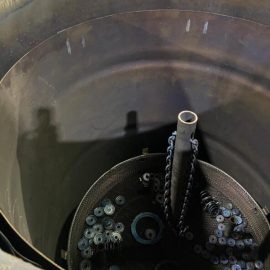Cementation, Nitriding And Carbonitriding Process
Cementation: The workpiece after cementation is quenched and tempered at low temperature, so that the surface has high hardness and wear resistance, while the core still maintains good plasticity and toughness, so as to meet the requirements of the workpiece to be hard on the outside and tough on the inside.
Nitriding: After nitriding, a layer of nitride is formed on the surface of the part, which can have high hardness, wear resistance, fatigue resistance and certain corrosion resistance without quenching, and the deformation is also small.
Carbonitriding: Also known as cyanidation. Carbonitriding is a treatment method in which carbon atoms and nitrogen atoms are simultaneously infiltrated into the surface of steel parts to form a carbonitriding layer to improve the hardness, wear resistance and fatigue strength of the workpiece.
In terms of process, definition and application
1. Cementation: It is divided into gas cementation and solid cementation; cementation is a chemical heat treatment method that saturates the surface of the part with activated carbon atoms in the austenite state to increase the carbon content on the surface of the part (increase the hardness). Nitrogen is also required during cementation, but due to the different temperature from carbonitriding, nitrogen is only a protective gas and plays a protective role.
2. Nitriding: gas nitriding and solid nitriding, gas nitriding is divided into soft nitriding and hard nitriding; (mainly cementation, nitrocementation mainly nitriding is called soft desalination). After nitriding (soft nitriding), the surface is usually silver gray (blue-black) or dark gray (blue-black). For workpieces of different materials, the surface color after nitriding (soft nitriding) is slightly different. Titanium and titanium alloys The surface of the piece is golden yellow.
3. Carbonitriding: It is a combination of the above two, that is, to achieve the depth of carburization, and to achieve the hardness of nitriding, and the overall performance is better. Carbonitriding is the addition of active nitrogen atoms on the basis of cementation.
Since the temperature required for the maximum saturation of carbon and nitrogen atoms on the steel surface is different, the temperature of the three heat treatment processes is also different, and the temperature of cementation is higher than that of carbonitriding.
Comprehensive: After quenching, high-carbon martensite is obtained on the surface of carburized parts, and high-carbon and nitrogen-containing martensite is obtained on the surface of carbonitrided parts. Due to the presence of nitrogen elements, the surface of the parts has better wear resistance.
Learn More :QT40-10 Ductile Iron Heat Treatment Process Equipment Composition And Details Of Large-Scale Finishing Rolling Steel Bar Heat Treatment Furnace Study on QPQ Nitriding Process of 42CrMo Piston Rod


Contact us
Your email address will not be published. Required fields are marked *